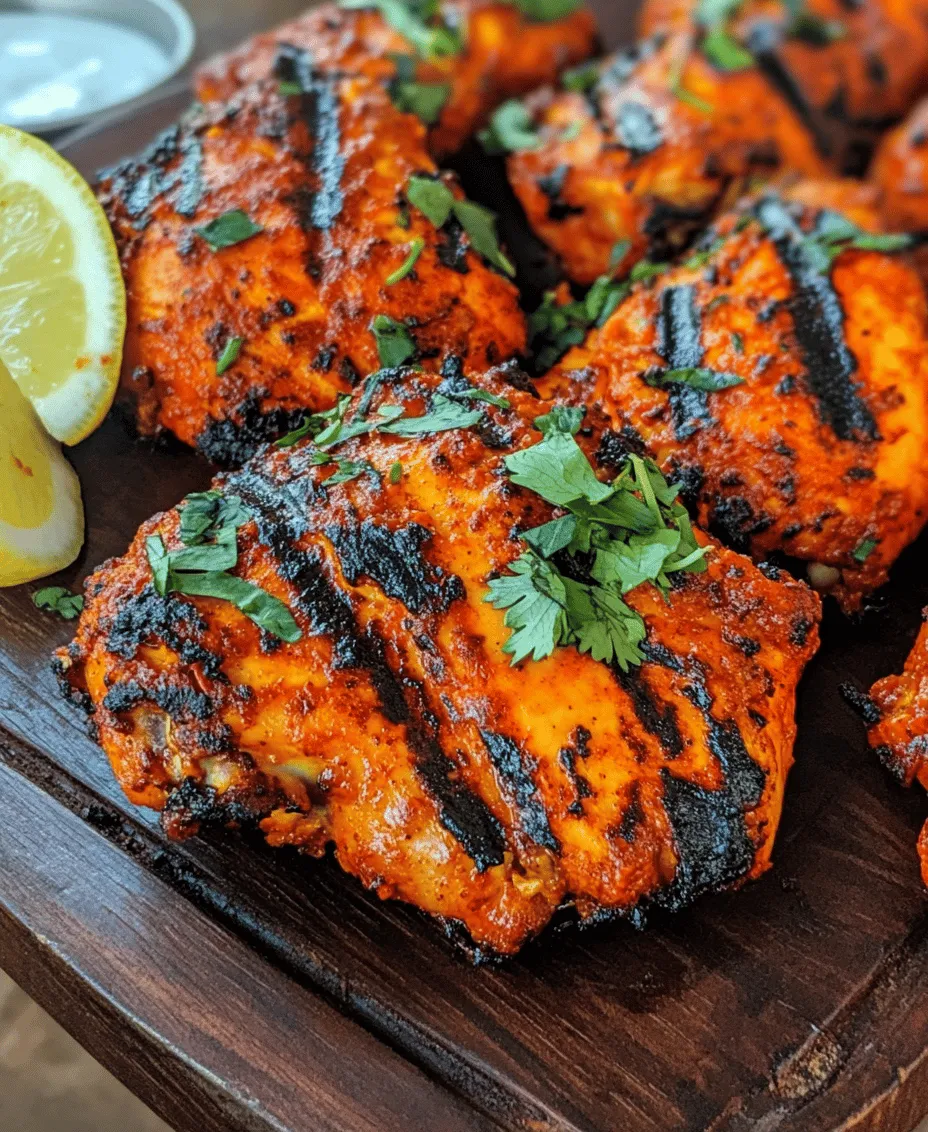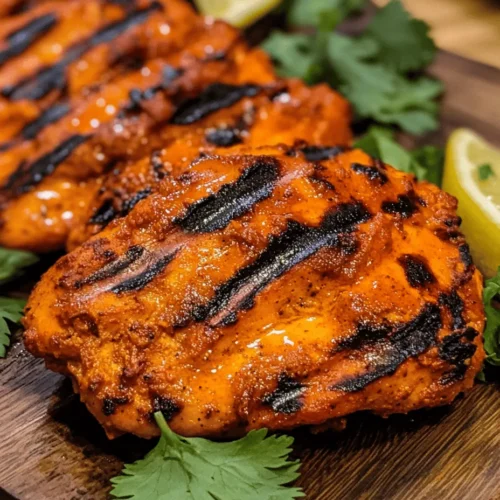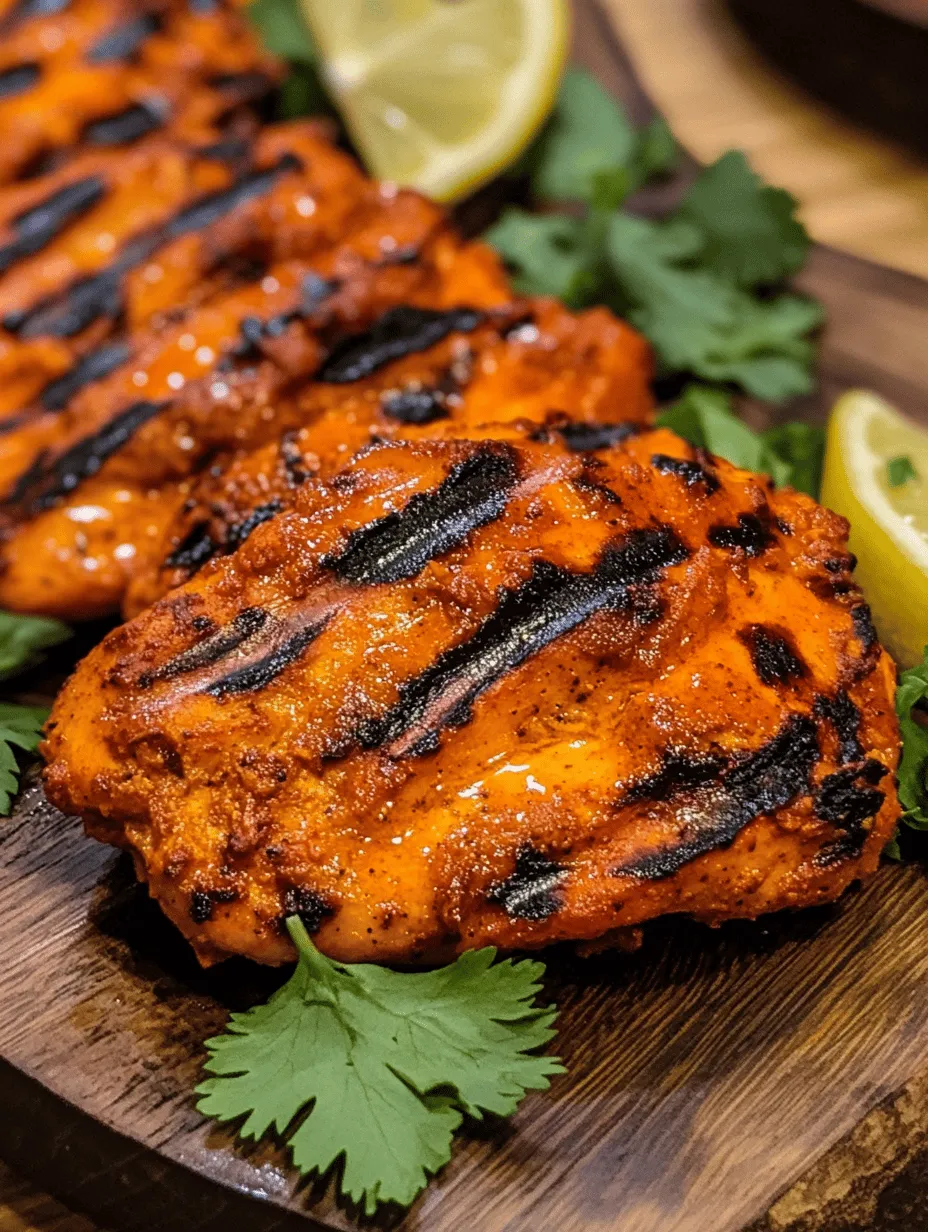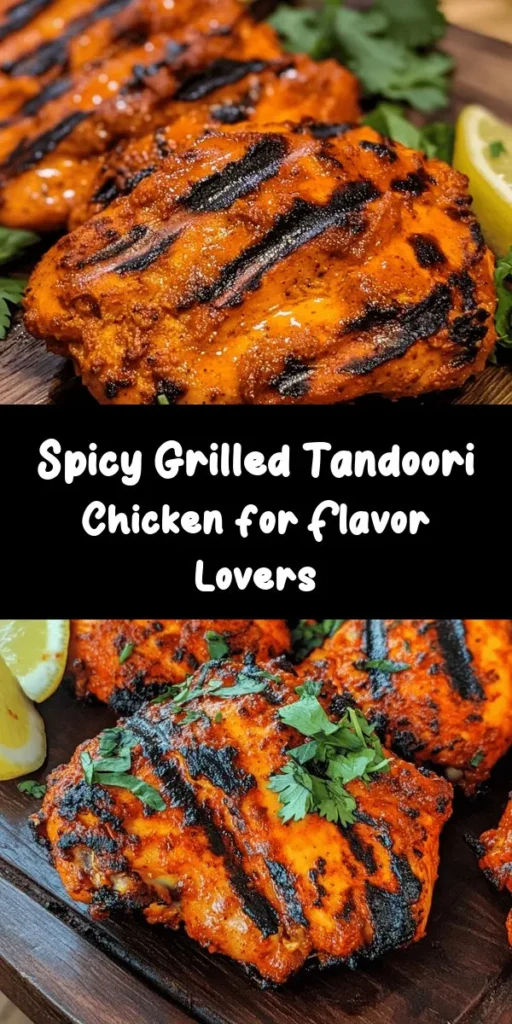Introduction
Tandoori chicken is a beloved dish that has transcended borders, enchanting taste buds well beyond its Indian roots. Characterized by its vibrant orange hue and the tantalizing aroma of spices, this dish is not just a meal; it’s an experience that captures the essence of traditional Indian cooking. Originating from the northern regions of India, particularly Punjab, Tandoori chicken is traditionally cooked in a tandoor, a clay oven that reaches high temperatures, creating perfectly charred and juicy chicken that’s infused with a symphony of flavors.
The magic of Tandoori chicken lies significantly in its marination process. Marinating chicken allows the spices and yogurt to penetrate the meat, tenderizing it while enhancing its flavor profile. This step is crucial, especially for those looking to recreate the authentic taste of Tandoori chicken at home. Whether you are a novice cook or a seasoned culinary enthusiast, this recipe offers an approachable yet authentic way to bring the taste of India to your kitchen.
In this article, we will delve into the traditional methods of preparing Tandoori chicken, the grilling technique that mimics its flavors, and the essential ingredients that make this dish a favorite among many. We’ll also provide you with a step-by-step guide to creating a marinade that ensures your chicken is bursting with flavor.
Understanding Tandoori Cooking
The traditional method of cooking Tandoori chicken involves the use of a tandoor, which is essentially a cylindrical clay oven. This ancient cooking technique not only provides high heat but also imparts a unique smoky flavor to the food. The walls of the tandoor are heated to extreme temperatures, allowing the chicken to cook quickly while remaining juicy and tender. The intense heat creates a beautiful char on the outside, sealing in the moisture and flavor.
However, not everyone has access to a tandoor, and that’s where grilling comes into play. Grilling is a fantastic alternative that can replicate the high heat and smoky essence of tandoor cooking. By using a grill, whether gas or charcoal, you can achieve similar effects, producing chicken that is both deliciously charred and flavorful. Moreover, grilling offers the added benefit of being more accessible for home cooks, allowing you to enjoy this iconic dish without the need for specialized equipment.
Key Ingredients Explained
To create an authentic Grilled Tandoori Chicken, it’s vital to understand the role of each ingredient in the recipe. Below, we’ll explore the key components that contribute to the dish’s distinctive taste and texture.
Chicken Thighs: The Ideal Choice
When it comes to Tandoori chicken, bone-in, skinless chicken thighs are the preferred cut. The reason behind this choice is simple: thighs are inherently more tender and flavorful than chicken breasts. The bone helps in retaining moisture during cooking, preventing the meat from drying out. This results in juicy, succulent chicken that absorbs the marinade’s flavors beautifully.
Yogurt: The Tenderizing Agent
Yogurt is a cornerstone of Tandoori chicken marinades. It serves two primary purposes: tenderizing the meat and enhancing flavor. The lactic acid in yogurt helps break down the proteins in the chicken, making it more tender. Additionally, yogurt adds a creamy texture and a slight tanginess that balances the spices, contributing to the overall depth of flavor.
Spices: The Heart of Tandoori Flavor
A blend of spices is what truly brings Tandoori chicken to life. Here’s a closer look at the essential spices that you will need:
– Ground Cumin and Coriander: These spices provide earthy undertones that form the backbone of the dish. Cumin adds warmth, while coriander imparts a subtle citrusy note.
– Smoked Paprika: Although not traditional, smoked paprika adds an extra layer of depth and smokiness that enhances the grilled flavor of the chicken.
– Turmeric and Cayenne: Turmeric gives the chicken its signature yellow color and adds a mild earthiness, while cayenne brings heat and a kick that balances the richness of the yogurt.
– Garam Masala: This aromatic spice blend is essential for an authentic flavor profile. It typically includes spices like cinnamon, cardamom, and cloves, contributing warmth and complexity to the dish.
– Fresh Ingredients: Don’t underestimate the power of fresh ginger and garlic. They add brightness and a pungent kick that elevates the overall flavor.
– Lemon Juice: A splash of lemon juice balances the richness of the marinade with its acidity, giving the chicken a bright finish and enhancing the flavors of the spices.
Preparing the Marinade
Creating the perfect marinade is crucial for achieving delicious Grilled Tandoori Chicken. Here’s a step-by-step guide to help you make a well-balanced marinade that will infuse your chicken with flavor and tenderness:
1. Gather Your Ingredients: Start by assembling all the key ingredients. You’ll need yogurt, ground cumin, ground coriander, smoked paprika, turmeric, cayenne pepper, garam masala, minced ginger, minced garlic, lemon juice, and salt.
2. Combine the Dry Spices: In a mixing bowl, combine the ground cumin, ground coriander, smoked paprika, turmeric, cayenne pepper, and garam masala. Mix well to ensure an even distribution of spices.
3. Mix the Wet Ingredients: In a separate bowl, combine the yogurt, minced ginger, minced garlic, lemon juice, and salt. Mix until smooth.
4. Incorporate the Spices: Gradually add the dry spice mixture to the wet ingredients, stirring continuously until you achieve a consistent marinade. The texture should be smooth and thick enough to coat the chicken without dripping off.
5. Adjust for Flavor: Taste the marinade and adjust the seasoning as necessary. If you prefer more heat, add a bit more cayenne. For extra acidity, a splash more of lemon juice can enhance the flavor further.
6. Marinate the Chicken: Add the chicken thighs to the marinade, ensuring each piece is thoroughly coated. You can use a resealable plastic bag for easy marination and to ensure that the flavors penetrate the meat evenly.
7. Chill and Marinate: Seal the bag or cover the bowl with plastic wrap and refrigerate. For the best results, allow the chicken to marinate for at least 4 hours, but overnight is ideal. The longer the chicken sits in the marinade, the more flavorful and tender it will become.
By following these steps, you’re setting yourself up for success in creating a mouthwatering Grilled Tandoori Chicken that rivals any restaurant version. The combination of spices, yogurt, and marination time results in chicken that is bursting with flavor, perfect for grilling season or any time you crave a taste of India.
Stay tuned for the next section where we’ll dive into the grilling process, tips for achieving the perfect char, and how to serve this delectable dish.

Importance of Marinating Time and Its Effect on the Chicken
Marination is a pivotal step in crafting the perfect Grilled Tandoori Chicken. It is not just about flavor; the duration of marinating can significantly affect the chicken’s tenderness and juiciness. When chicken is marinated in a mixture of yogurt and spices, the acids and enzymes in the yogurt work to break down the protein fibers, allowing the chicken to absorb the flavors deeply. Ideally, you should let your chicken marinate for a minimum of 2 hours; however, for the best results, marinating overnight is recommended. This extended time allows the spices to penetrate thoroughly, enhancing both taste and texture.
A well-marinated chicken will result in a succulent and flavorful dish that is the hallmark of traditional Tandoori cooking. If time permits, consider using a zip-top bag to ensure that every piece of chicken is evenly coated in the marinade. This technique also helps eliminate excess air, further accelerating the marination process.
Grilling Techniques for Perfectly Cooked Chicken
Preparing Your Grill for Optimal Cooking
Before placing the chicken on the grill, it is essential to prepare the grill properly. Start by cleaning the grates with a wire brush to remove any remnants from previous cooking sessions. This ensures that your Tandoori chicken won’t stick and that the flavors remain pure. Next, oil the grates lightly using a paper towel dipped in vegetable oil, which will help prevent sticking and enhance the grill marks on the chicken.
For a charcoal grill, arrange the coals in a two-zone setup: one side should be hot for searing, while the other should be cooler for cooking through. For gas grills, preheat on high for about 10-15 minutes before adjusting to medium heat. The ideal grilling temperature for chicken is around 375°F to 400°F. This range allows the chicken to cook evenly without burning the exterior.
Tips on Maintaining the Right Temperature and Avoiding Flare-Ups
Maintaining a steady temperature is crucial for even cooking. If you notice flare-ups due to excess marinade or fat, move the chicken to the cooler side of the grill until the flames subside. You can also close the lid momentarily to contain the heat and reduce flare-ups.
Keep an eye on the chicken as it cooks. To achieve that perfect char without overcooking, turn the chicken every few minutes. Using tongs, flip the pieces gently to ensure they don’t lose their marinade coating. This technique not only helps in obtaining those beautiful grill marks but also allows the chicken to cook thoroughly.
The Importance of Timing and Checking Internal Temperature for Doneness
Cooking time will depend on the size of the chicken pieces. Generally, chicken thighs will take about 15-20 minutes to cook through, while breasts may require slightly less time. To ensure safety and proper doneness, you should always use a meat thermometer. The internal temperature of the chicken should reach at least 165°F. Once you reach this temperature, allow the chicken to rest before serving—this is a crucial step that enhances juiciness.
Resting and Serving
Why Resting the Chicken is Crucial for Juiciness
After grilling, let the chicken rest for about 5-10 minutes before serving. This resting period allows the juices, which are driven to the center of the meat during cooking, to redistribute throughout the chicken. Cutting into the chicken too soon will cause these juices to escape, resulting in a dry texture. Resting ensures that every bite remains moist and flavorful.
Suggestions for Garnishing and Serving
Presentation is key when serving your Grilled Tandoori Chicken. Consider garnishing it with fresh cilantro, which provides a burst of color and enhances the flavor profile. Cilantro’s bright, herbal notes complement the smoky, spicy chicken beautifully.
To elevate the dish further, serve with lemon wedges on the side. Squeezing fresh lemon juice over the chicken just before eating adds a zesty brightness that cuts through the richness of the marinade, making each bite even more enjoyable.
Recommended Sides to Complement the Dish
Grilled Tandoori Chicken pairs beautifully with a variety of sides. Traditional accompaniments include warm naan bread and fragrant basmati rice. Naan is perfect for scooping up the chicken and soaking up any leftover juices, while basmati rice provides a neutral base that balances the spices. For a fresh touch, consider a cucumber raita—a yogurt-based side that cools the palate and complements the spices in the chicken.
Nutritional Benefits of Grilled Tandoori Chicken
Overview of the Health Benefits of Using Chicken Thighs and Yogurt
Grilled Tandoori Chicken is not only delicious but also nutritious. Using chicken thighs instead of breasts can be beneficial, as thighs are generally more tender and flavorful due to their higher fat content. They also offer a good source of protein, essential for muscle repair and overall health.
The yogurt in the marinade enhances the dish’s nutritional profile. It is rich in protein and probiotics, which contribute to gut health. Additionally, yogurt helps tenderize the chicken, making it easier to digest.
Discussion on the Balance of Spices and Their Health Properties
The blend of spices used in Tandoori chicken—such as turmeric, cumin, coriander, and cayenne—are not just for flavor. Each spice comes with its own health benefits. For example, turmeric contains curcumin, known for its anti-inflammatory properties, while cumin is rich in antioxidants. These spices not only enhance the taste of the chicken but also contribute to overall well-being.
Comparison with Other Traditional Chicken Preparations
When compared to other traditional chicken preparations like fried chicken or creamy chicken dishes, Grilled Tandoori Chicken stands out as a healthier option. The grilling method reduces the amount of added fat, while the spices provide robust flavor without the need for heavy sauces.
Cultural Significance of Tandoori Cuisine
Exploration of Tandoori Chicken’s Place in Indian Culture and Festivals
Tandoori chicken holds a special place in Indian cuisine, celebrated for its vibrant flavors and rich history. Traditionally cooked in a clay oven known as a tandoor, this dish has become synonymous with Indian cooking. It is often served during festive occasions, family gatherings, and special celebrations, symbolizing hospitality and warmth.
How This Dish Has Evolved and Gained Popularity Globally
Over the years, Tandoori chicken has transcended borders, gaining popularity worldwide. Its unique flavor profile has made it a staple in Indian restaurants across the globe. The dish’s versatility has led to numerous adaptations, from Tandoori wraps to Tandoori pizza, showcasing how traditional cuisine can be embraced and reinterpreted in modern cooking.
Variations of Tandoori Chicken in Different Regions
Tandoori chicken is not a one-size-fits-all dish. Different regions in India have their own variations, often incorporating local spices and cooking techniques. For example, in North India, you might find a richer, creamier version, while in the South, it may be spiced with coconut and curry leaves. These regional adaptations highlight the diversity of Indian cuisine and the many ways Tandoori chicken can be enjoyed.
Conclusion
In conclusion, mastering the art of Grilled Tandoori Chicken opens the door to a world of vibrant flavors and culinary traditions. From the importance of marinating to perfect grilling techniques, every step contributes to the dish’s final success. The nutritional benefits and cultural significance further enhance its appeal, making it a worthwhile addition to any meal.
By trying this recipe, you not only indulge in a delicious feast but also experience the rich heritage of Indian cuisine right in your kitchen. So gather your ingredients, fire up the grill, and enjoy the process of cooking and sharing this delightful dish with your loved ones. The joy of preparing a meal that carries the essence of tradition and flavor is truly unmatched.



